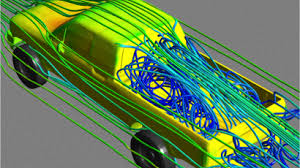Computational fluid dynamics is a branch of fluid machines which helps to calculate and analyses the flow of liquid and gas. Computational fluid dynamics works on the Navier Stokes equations which describes about single phase fluid flow. With the combination of physics, applied mathematics and computational software the Computational fluid dynamics predicts the effect of liquid and gas on the object.
The growth in automotive industry creates substantial opportunities for the computational fluid dynamics market as well. According to “Organisation Internationale des Constructeurs d’Automobiles”, in 2016, 98.8 million units of vehicles were sold worldwide up from 89.7 million in 2015. This signifies that the CFD market will witness an exponential growth over the forecast period. In addition to this, the increasing R&D investment in aerospace & defense industry provides significant growth opportunity to the global CFD market.
A major challenge hindering the market growth in aerospace & defense industry is the relatively slow adoption of cloud-based solutions due to data security and privacy issues because of hacking and various other attacks on cloud infrastructure. In spite of the fact that a couple of venders are providing the cloud-based model, various end users are unwilling to purchase it. Moreover, customers prefer using open source CFD software rather than spending huge amount on purchasing commercial licenses. The above said factor is also expected to restrain the market growth over the forecast period.
Get Sample Copy @ https://www.coherentmarketinsights.com/insight/request-sample/654
Computational Fluid Dynamics Market Taxonomy
On the basis of deployment model, the global Computational Fluid Dynamics market is classified into:
Cloud-based model
On-premises model
With the development in cloud services, the demand for data centers has also increased significantly. Computational fluid dynamics is generally utilized for thermal modeling in data centers as it helps in identifying areas with lesser air flow. It also offers the 3-D view of cold air movement which helps to provide the cooling in the data center racks. Furthermore, area that is exposed to more cooling than actually required can be easily identified by utilizing CFD. Since CFD is useful for understanding the changes that result from the addition of new hardware, its demand among the end users is projected to rise significantly over the upcoming years.
On the basis of end-use industry, the global Computational Fluid Dynamics market is classified into:
Automotive
Aerospace & Defense
Electrical and electronics
Industrial machinery
Energy
Others
Computational Fluid Dynamics Market Outlook – North America holds the largest market share
North America held the largest market share of the global computational fluid dynamics market in 2016 and is expected to continue its dominance over the forecast period followed by Europe. The high R&D investment in aerospace & defense in the U.S. offers substantial growth opportunity to the CFD market in the region. The U.S. has invested US$ 14.3 billion for R&D in the aerospace & defense industry in 2016. One of the key trends in the Asia Pacific market is the rising use of integrated CFD software that can propel the effectiveness of product development life cycle. Some CFD companies and product lifecycle management have started offering integrated CFD software with some other product lifecycle management tools to enhance the productivity of product development cycle.
Computational Fluid Dynamics Market Players
ANSYS, Inc., CD-Adapco, Mentor Graphics, Inc., Altair, Applied Math Modeling, Ceetron, Dassault Systèmes, ESI, Exa, FloSolve, Simerics, and Symscap are some of the major companies identified across the value chain of global CFD market.
Download PDF Brochure @ https://www.coherentmarketinsights.com/insight/request-pdf/654



